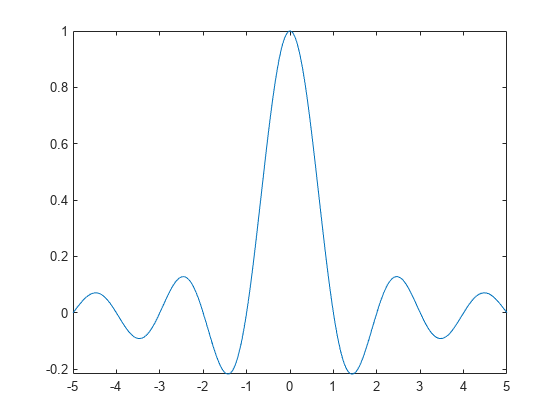sinc
Normalized sinc function
Syntax
Description
Examples
Sinc Function of Symbolic Inputs
Create a sinc function of a symbolic variable x.
syms x
sinc(x)ans =
Show that sinc returns 1 at 0, 0 at other integer inputs, and exact symbolic values for other inputs.
V = sym([-1 0 1 3/2]); S = sinc(V)
S =
Convert the exact symbolic output to high-precision floating point by using vpa.
vpa(S)
ans =
Fourier Transforms Involving Sinc Function
Although sinc can appear in tables of Fourier transforms, fourier does not return sinc in output.
Show that fourier transforms a pulse in terms of sin and cos.
syms x
fourier(rectangularPulse(x))ans =
Show that fourier transforms sinc in terms of heaviside.
fourier(sinc(x))
ans =
Plot Sinc Function
Rewrite Sinc Function to Other Functions
Rewrite the sinc function to the exponential function exp by using rewrite.
syms x rewrite(sinc(x),'exp')
ans =
Differentiate, Integrate, and Expand the Sinc Function
Differentiate, integrate, and expand sinc by using the diff, int, and taylor functions, respectively.
Differentiate sinc.
syms x
diff(sinc(x))ans =
Integrate sinc from -Inf to Inf.
int(sinc(x),[-Inf Inf])
ans =
Integrate sinc from -Inf to x.
int(sinc(x),-Inf,x)
ans =
Find the Taylor expansion of sinc.
taylor(sinc(x))
ans =
Prove Identity Involving Sinc Function
Prove an identity by defining the identity as a condition and using the isAlways function to check the condition.
Prove the identity .
syms x
cond = sinc(x) == 1/(gamma(1+x)*gamma(1-x));
isAlways(cond)ans = logical
1
Input Arguments
x — Input
number | vector | matrix | array | symbolic number | symbolic variable | symbolic array | symbolic function | symbolic expression
Input, specified as a number, vector, matrix, or array, or a symbolic number, variable, array, function, or expression.
Version History
Introduced in R2018b
See Also
MATLAB 命令
您点击的链接对应于以下 MATLAB 命令:
请在 MATLAB 命令行窗口中直接输入以执行命令。Web 浏览器不支持 MATLAB 命令。

Select a Web Site
Choose a web site to get translated content where available and see local events and offers. Based on your location, we recommend that you select: .
You can also select a web site from the following list:
How to Get Best Site Performance
Select the China site (in Chinese or English) for best site performance. Other MathWorks country sites are not optimized for visits from your location.
Americas
- América Latina (Español)
- Canada (English)
- United States (English)
Europe
- Belgium (English)
- Denmark (English)
- Deutschland (Deutsch)
- España (Español)
- Finland (English)
- France (Français)
- Ireland (English)
- Italia (Italiano)
- Luxembourg (English)
- Netherlands (English)
- Norway (English)
- Österreich (Deutsch)
- Portugal (English)
- Sweden (English)
- Switzerland
- United Kingdom (English)
